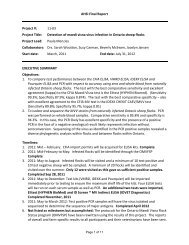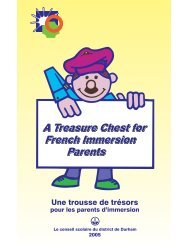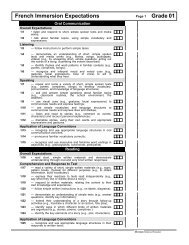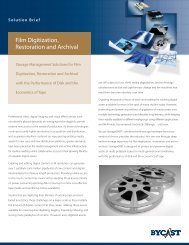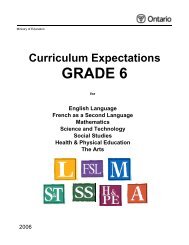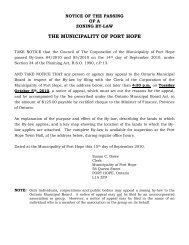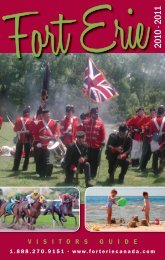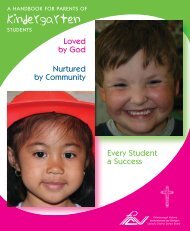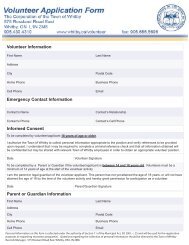GRADE 3 - PVNC Catholic District School Board
GRADE 3 - PVNC Catholic District School Board
GRADE 3 - PVNC Catholic District School Board
Create successful ePaper yourself
Turn your PDF publications into a flip-book with our unique Google optimized e-Paper software.
The Arts Expectations<br />
Drama & Dance<br />
Overall Expectations<br />
3a40 • describe basic elements of drama and dance (e.g., suspense, pattern,<br />
energy);<br />
3a41 • interpret and communicate the meaning of stories, poems, plays, and other<br />
material drawn from a range of sources and cultures, using basic drama and<br />
dance techniques (e.g., writing in role);<br />
3a42 • create short dance pieces, using techniques learned in this grade;<br />
3a43 • compare their own work with the work of others in drama and dance through<br />
discussion, writing, movement, and visual art work;<br />
3a44 • solve problems presented in different kinds of dramatic situations through<br />
role playing and movement;<br />
3a45 • use available technology appropriately to enhance their work in drama and<br />
dance.<br />
Knowledge of Elements<br />
3a46 – demonstrate an understanding of a character’s point of view through writing<br />
and speaking in role, and through using body movement in role (e.g., write<br />
diary entries and plant grain as a pioneer in Upper Canada);<br />
3a47 – describe their own and others’ work in drama and dance, using appropriate<br />
vocabulary (e.g., character, suspense, rhythm);<br />
3a48 – explain the importance of symbols used in specific stories, poems, and<br />
dances;<br />
3a49 – demonstrate the ability to concentrate while in role in drama and dance (e.g.,<br />
during an improvisation; while performing a dance);<br />
3a50 – recognize and choose appropriate elements of movement for dramatizing<br />
their responses to different stimuli or ideas (e.g., real-life situations, the<br />
scientific concept of magnetic force);<br />
3a51 – identify technological means of creating different effects (e.g., the use of<br />
recorded music or lighting to heighten suspense);<br />
3a52 – describe the kinds of energy involved in a sequence of movements (e.g.,<br />
energy related to speed or force);<br />
3a53 – distinguish between a variety of dance forms, using specific criteria (e.g.,<br />
steps, music, costumes).<br />
Creative Work<br />
3a54 – defend a point of view through speaking and writing in role (e.g., as<br />
townsfolk, plead with the mayor to save their town);<br />
3a55 – create works of drama and dance, using appropriate elements (e.g., rhythm,<br />
form);<br />
3a56 – communicate, through movement, their thoughts and feelings about topics<br />
studied in other subject areas (e.g., create a movement sequence to express<br />
their fear of an environmental event such as a storm);<br />
3a57 – write and perform chants.<br />
Critical Thinking<br />
3a58 – identify effective uses of drama and dance elements in performances (e.g.,<br />
form, space, pattern, energy) and compare their own responses with those of<br />
their peers;<br />
3a59 – identify the themes and subjects found in drama and dance works, and make<br />
links between these and their own experiences;<br />
3a60 – clarify the meaning of complex or ambiguous dramatic situations (e.g., by<br />
posing questions in and out of role to characters in a drama);<br />
3a61 – solve artistic problems in drama and dance in cooperative work groups (e.g.,<br />
discuss the effect of combining different voices in choral reading; discuss the<br />
effects of using one dancer or several to convey a message);<br />
Grade 03<br />
Ministry of Education



